height Hyundai Sonata
[x] Cancel search | Manufacturer: HYUNDAI, Model Year: , Model line: , Model:Pages: 285, PDF Size: 9.38 MB
Page 29 of 285
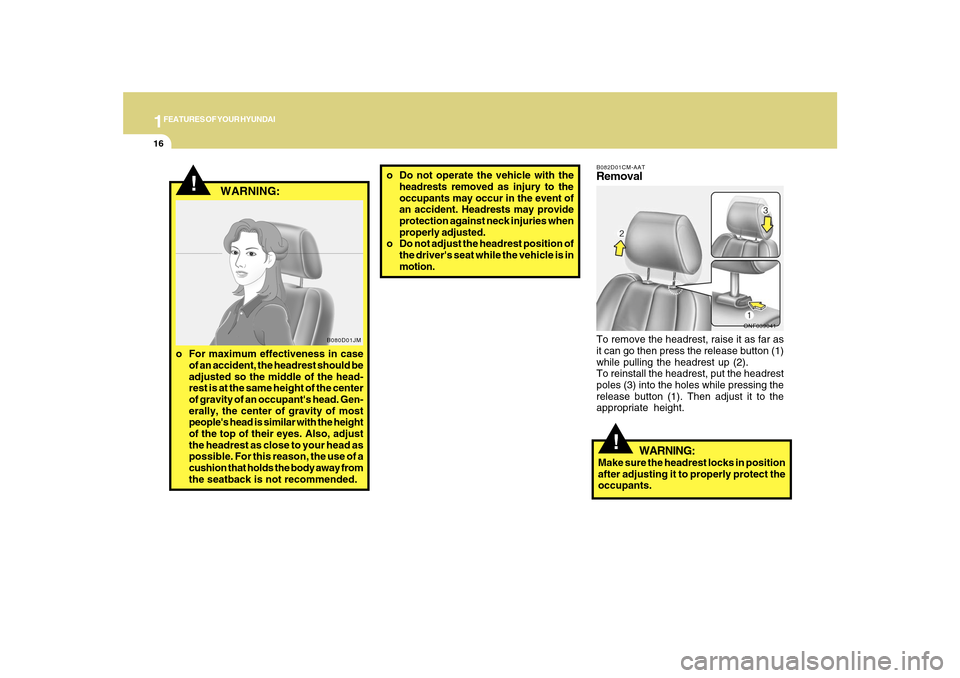
1FEATURES OF YOUR HYUNDAI16
o Do not operate the vehicle with the
headrests removed as injury to the
occupants may occur in the event of
an accident. Headrests may provide
protection against neck injuries when
properly adjusted.
o Do not adjust the headrest position of
the driver's seat while the vehicle is in
motion.
B082D01CM-AATRemovalTo remove the headrest, raise it as far as
it can go then press the release button (1)
while pulling the headrest up (2).
To reinstall the headrest, put the headrest
poles (3) into the holes while pressing the
release button (1). Then adjust it to the
appropriate height.
ONF039041
WARNING:
Make sure the headrest locks in position
after adjusting it to properly protect the
occupants.
!
!
WARNING:
o For maximum effectiveness in case
of an accident, the headrest should be
adjusted so the middle of the head-
rest is at the same height of the center
of gravity of an occupant's head. Gen-
erally, the center of gravity of most
people's head is similar with the height
of the top of their eyes. Also, adjust
the headrest as close to your head as
possible. For this reason, the use of a
cushion that holds the body away from
the seatback is not recommended.
B080D01JM
Page 30 of 285
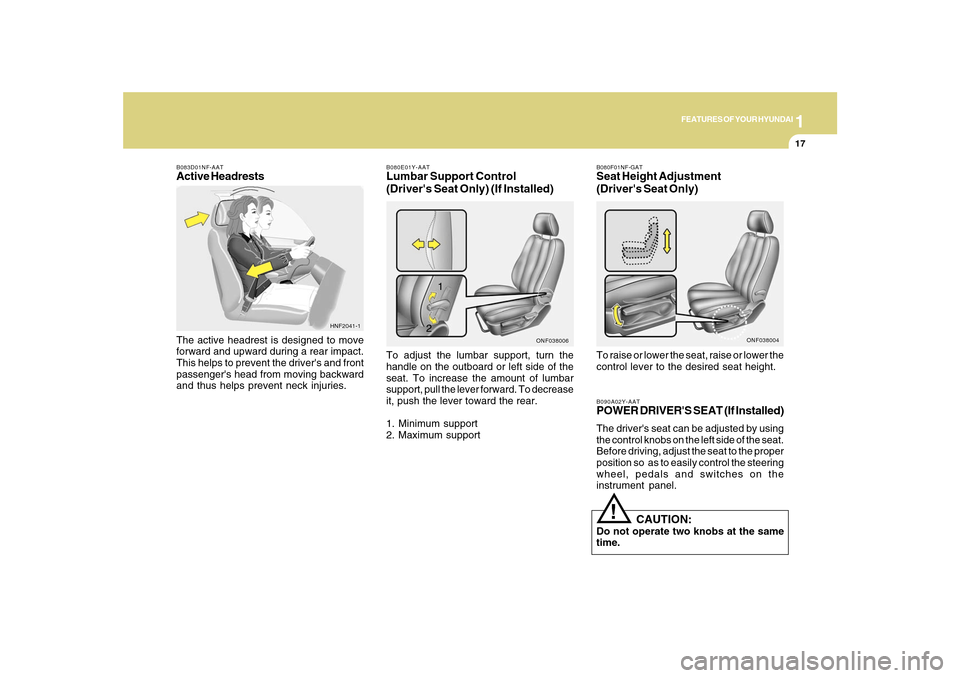
1
FEATURES OF YOUR HYUNDAI
17
B080E01Y-AATLumbar Support Control
(Driver's Seat Only) (If Installed)To adjust the lumbar support, turn the
handle on the outboard or left side of the
seat. To increase the amount of lumbar
support, pull the lever forward. To decrease
it, push the lever toward the rear.
1. Minimum support
2. Maximum support
ONF038006
2
B090A02Y-AATPOWER DRIVER'S SEAT (If Installed)The driver's seat can be adjusted by using
the control knobs on the left side of the seat.
Before driving, adjust the seat to the proper
position so as to easily control the steering
wheel, pedals and switches on the
instrument panel.
CAUTION:
Do not operate two knobs at the same
time.
!
B080F01NF-GATSeat Height Adjustment
(Driver's Seat Only)To raise or lower the seat, raise or lower the
control lever to the desired seat height.
ONF038004
1
B083D01NF-AATActive HeadrestsThe active headrest is designed to move
forward and upward during a rear impact.
This helps to prevent the driver's and front
passenger's head from moving backward
and thus helps prevent neck injuries.
HNF2041-1
Page 31 of 285
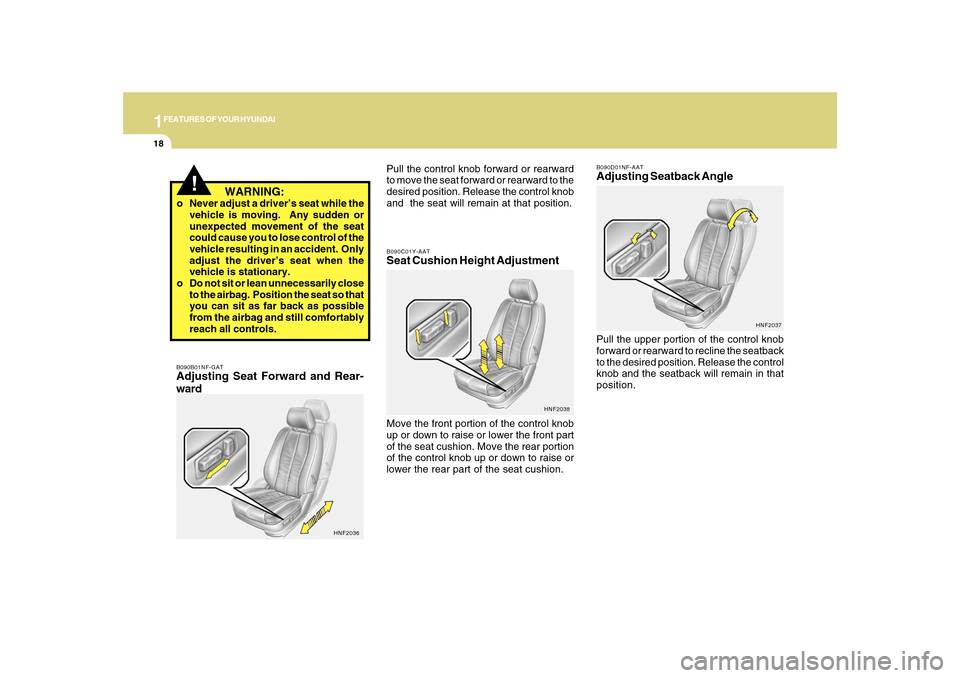
1FEATURES OF YOUR HYUNDAI18
B090D01NF-AATAdjusting Seatback AnglePull the upper portion of the control knob
forward or rearward to recline the seatback
to the desired position. Release the control
knob and the seatback will remain in that
position.
B090C01Y-AATSeat Cushion Height AdjustmentMove the front portion of the control knob
up or down to raise or lower the front part
of the seat cushion. Move the rear portion
of the control knob up or down to raise or
lower the rear part of the seat cushion.
HNF2038
HNF2037
Pull the control knob forward or rearward
to move the seat forward or rearward to the
desired position. Release the control knob
and the seat will remain at that position.
!
WARNING:
o Never adjust a driver’s seat while the
vehicle is moving. Any sudden or
unexpected movement of the seat
could cause you to lose control of the
vehicle resulting in an accident. Only
adjust the driver’s seat when the
vehicle is stationary.
o Do not sit or lean unnecessarily close
to the airbag. Position the seat so that
you can sit as far back as possible
from the airbag and still comfortably
reach all controls.B090B01NF-GATAdjusting Seat Forward and Rear-
ward
HNF2036
Page 33 of 285
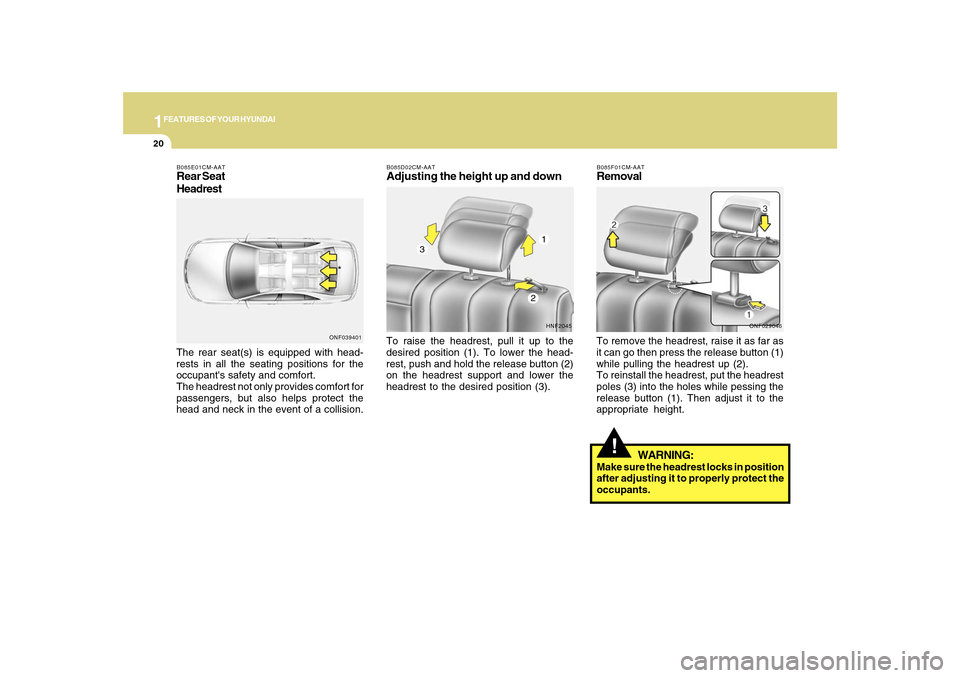
1FEATURES OF YOUR HYUNDAI20
B085D02CM-AATAdjusting the height up and downTo raise the headrest, pull it up to the
desired position (1). To lower the head-
rest, push and hold the release button (2)
on the headrest support and lower the
headrest to the desired position (3).
B085E01CM-AATRear Seat
HeadrestThe rear seat(s) is equipped with head-
rests in all the seating positions for the
occupant's safety and comfort.
The headrest not only provides comfort for
passengers, but also helps protect the
head and neck in the event of a collision.
ONF039401
!
WARNING:
Make sure the headrest locks in position
after adjusting it to properly protect the
occupants.B085F01CM-AATRemovalTo remove the headrest, raise it as far as
it can go then press the release button (1)
while pulling the headrest up (2).
To reinstall the headrest, put the headrest
poles (3) into the holes while pessing the
release button (1). Then adjust it to the
appropriate height.
ONF029046
*
HNF204512
3
Page 34 of 285
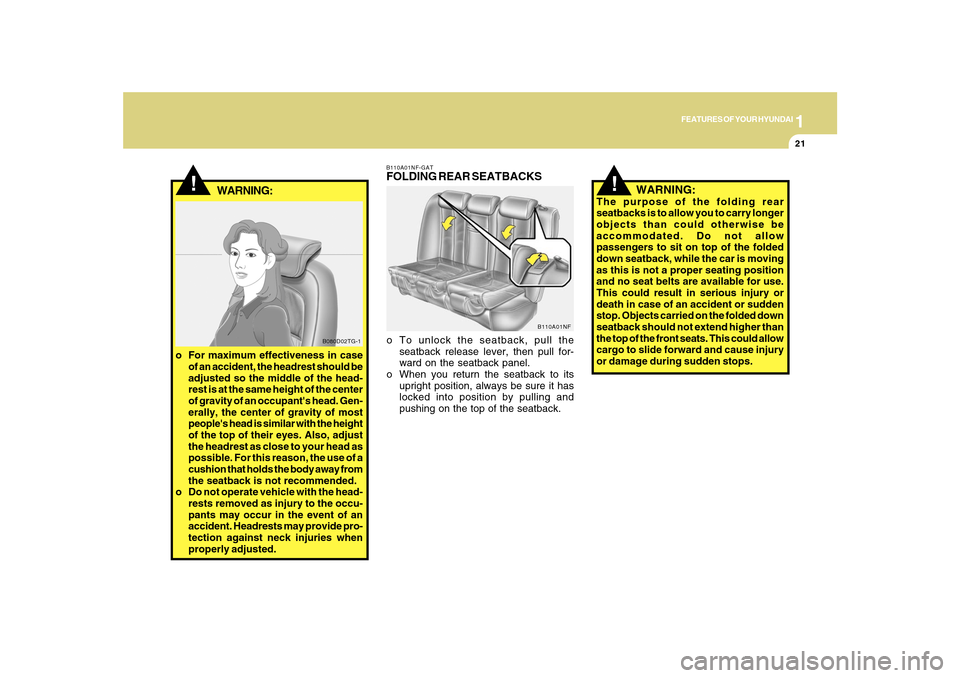
1
FEATURES OF YOUR HYUNDAI
21
!
WARNING:
The purpose of the folding rear
seatbacks is to allow you to carry longer
objects than could otherwise be
accommodated. Do not allow
passengers to sit on top of the folded
down seatback, while the car is moving
as this is not a proper seating position
and no seat belts are available for use.
This could result in serious injury or
death in case of an accident or sudden
stop. Objects carried on the folded down
seatback should not extend higher than
the top of the front seats. This could allow
cargo to slide forward and cause injury
or damage during sudden stops.
B110A01NF-GATFOLDING REAR SEATBACKSo To unlock the seatback, pull the
seatback release lever, then pull for-
ward on the seatback panel.
o When you return the seatback to its
upright position, always be sure it has
locked into position by pulling and
pushing on the top of the seatback.
B110A01NF
!
WARNING:
B080D02TG-1
o For maximum effectiveness in case
of an accident, the headrest should be
adjusted so the middle of the head-
rest is at the same height of the center
of gravity of an occupant's head. Gen-
erally, the center of gravity of most
people's head is similar with the height
of the top of their eyes. Also, adjust
the headrest as close to your head as
possible. For this reason, the use of a
cushion that holds the body away from
the seatback is not recommended.
o Do not operate vehicle with the head-
rests removed as injury to the occu-
pants may occur in the event of an
accident. Headrests may provide pro-
tection against neck injuries when
properly adjusted.
Page 35 of 285
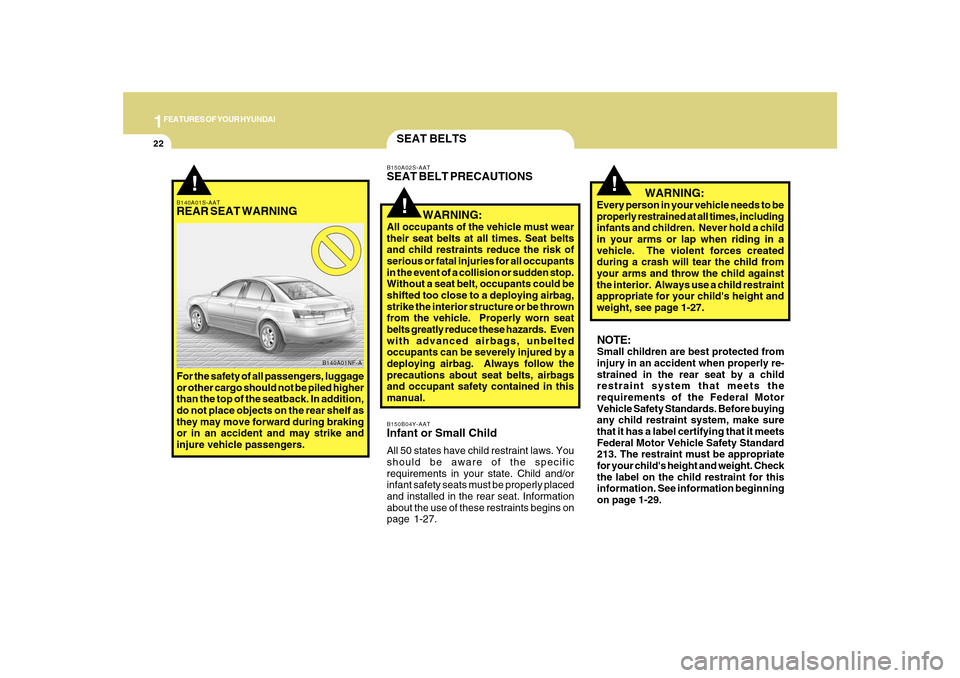
1FEATURES OF YOUR HYUNDAI22
SEAT BELTSB150B04Y-AATInfant or Small ChildAll 50 states have child restraint laws. You
should be aware of the specific
requirements in your state. Child and/or
infant safety seats must be properly placed
and installed in the rear seat. Information
about the use of these restraints begins on
page 1-27.
!
B150A02S-AATSEAT BELT PRECAUTIONS
WARNING:All occupants of the vehicle must wear
their seat belts at all times. Seat belts
and child restraints reduce the risk of
serious or fatal injuries for all occupants
in the event of a collision or sudden stop.
Without a seat belt, occupants could be
shifted too close to a deploying airbag,
strike the interior structure or be thrown
from the vehicle. Properly worn seat
belts greatly reduce these hazards. Even
with advanced airbags, unbelted
occupants can be severely injured by a
deploying airbag. Always follow the
precautions about seat belts, airbags
and occupant safety contained in this
manual.
!
WARNING:
Every person in your vehicle needs to be
properly restrained at all times, including
infants and children. Never hold a child
in your arms or lap when riding in a
vehicle. The violent forces created
during a crash will tear the child from
your arms and throw the child against
the interior. Always use a child restraint
appropriate for your child's height and
weight, see page 1-27.NOTE:Small children are best protected from
injury in an accident when properly re-
strained in the rear seat by a child
restraint system that meets the
requirements of the Federal Motor
Vehicle Safety Standards. Before buying
any child restraint system, make sure
that it has a label certifying that it meets
Federal Motor Vehicle Safety Standard
213. The restraint must be appropriate
for your child's height and weight. Check
the label on the child restraint for this
information. See information beginning
on page 1-29.
!
B140A01S-AATREAR SEAT WARNINGFor the safety of all passengers, luggage
or other cargo should not be piled higher
than the top of the seatback. In addition,
do not place objects on the rear shelf as
they may move forward during braking
or in an accident and may strike and
injure vehicle passengers.
B140A01NF-A
Page 37 of 285
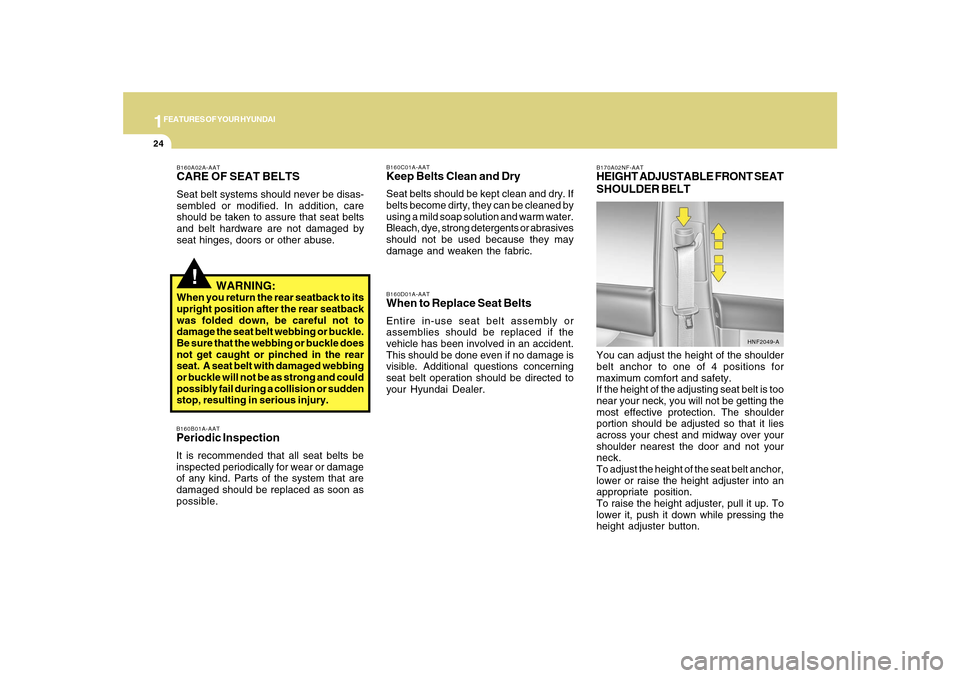
1FEATURES OF YOUR HYUNDAI24
!
B160A02A-AATCARE OF SEAT BELTSSeat belt systems should never be disas-
sembled or modified. In addition, care
should be taken to assure that seat belts
and belt hardware are not damaged by
seat hinges, doors or other abuse.
WARNING:
When you return the rear seatback to its
upright position after the rear seatback
was folded down, be careful not to
damage the seat belt webbing or buckle.
Be sure that the webbing or buckle does
not get caught or pinched in the rear
seat. A seat belt with damaged webbing
or buckle will not be as strong and could
possibly fail during a collision or sudden
stop, resulting in serious injury.B160B01A-AATPeriodic InspectionIt is recommended that all seat belts be
inspected periodically for wear or damage
of any kind. Parts of the system that are
damaged should be replaced as soon as
possible.
B160C01A-AATKeep Belts Clean and DrySeat belts should be kept clean and dry. If
belts become dirty, they can be cleaned by
using a mild soap solution and warm water.
Bleach, dye, strong detergents or abrasives
should not be used because they may
damage and weaken the fabric.B160D01A-AATWhen to Replace Seat BeltsEntire in-use seat belt assembly or
assemblies should be replaced if the
vehicle has been involved in an accident.
This should be done even if no damage is
visible. Additional questions concerning
seat belt operation should be directed to
your Hyundai Dealer.
B170A02NF-AATHEIGHT ADJUSTABLE FRONT SEAT
SHOULDER BELTYou can adjust the height of the shoulder
belt anchor to one of 4 positions for
maximum comfort and safety.
If the height of the adjusting seat belt is too
near your neck, you will not be getting the
most effective protection. The shoulder
portion should be adjusted so that it lies
across your chest and midway over your
shoulder nearest the door and not your
neck.
To adjust the height of the seat belt anchor,
lower or raise the height adjuster into an
appropriate position.
To raise the height adjuster, pull it up. To
lower it, push it down while pressing the
height adjuster button.
HNF2049-A
Page 38 of 285
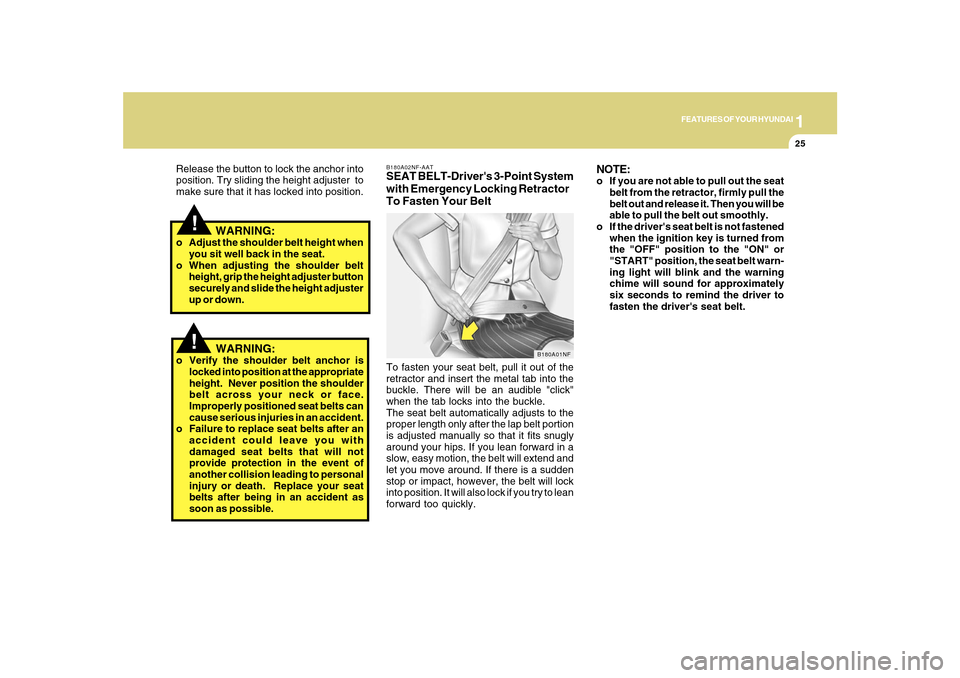
1
FEATURES OF YOUR HYUNDAI
25
B180A02NF-AATSEAT BELT-Driver's 3-Point System
with Emergency Locking Retractor
To Fasten Your BeltTo fasten your seat belt, pull it out of the
retractor and insert the metal tab into the
buckle. There will be an audible "click"
when the tab locks into the buckle.
The seat belt automatically adjusts to the
proper length only after the lap belt portion
is adjusted manually so that it fits snugly
around your hips. If you lean forward in a
slow, easy motion, the belt will extend and
let you move around. If there is a sudden
stop or impact, however, the belt will lock
into position. It will also lock if you try to lean
forward too quickly.
B180A01NF
NOTE:o If you are not able to pull out the seat
belt from the retractor, firmly pull the
belt out and release it. Then you will be
able to pull the belt out smoothly.
o If the driver's seat belt is not fastened
when the ignition key is turned from
the "OFF" position to the "ON" or
"START" position, the seat belt warn-
ing light will blink and the warning
chime will sound for approximately
six seconds to remind the driver to
fasten the driver's seat belt.
!
Release the button to lock the anchor into
position. Try sliding the height adjuster to
make sure that it has locked into position.
WARNING:
o Verify the shoulder belt anchor is
locked into position at the appropriate
height. Never position the shoulder
belt across your neck or face.
Improperly positioned seat belts can
cause serious injuries in an accident.
o Failure to replace seat belts after an
accident could leave you with
damaged seat belts that will not
provide protection in the event of
another collision leading to personal
injury or death. Replace your seat
belts after being in an accident as
soon as possible.
!
WARNING:
o Adjust the shoulder belt height when
you sit well back in the seat.
o When adjusting the shoulder belt
height, grip the height adjuster button
securely and slide the height adjuster
up or down.
Page 62 of 285
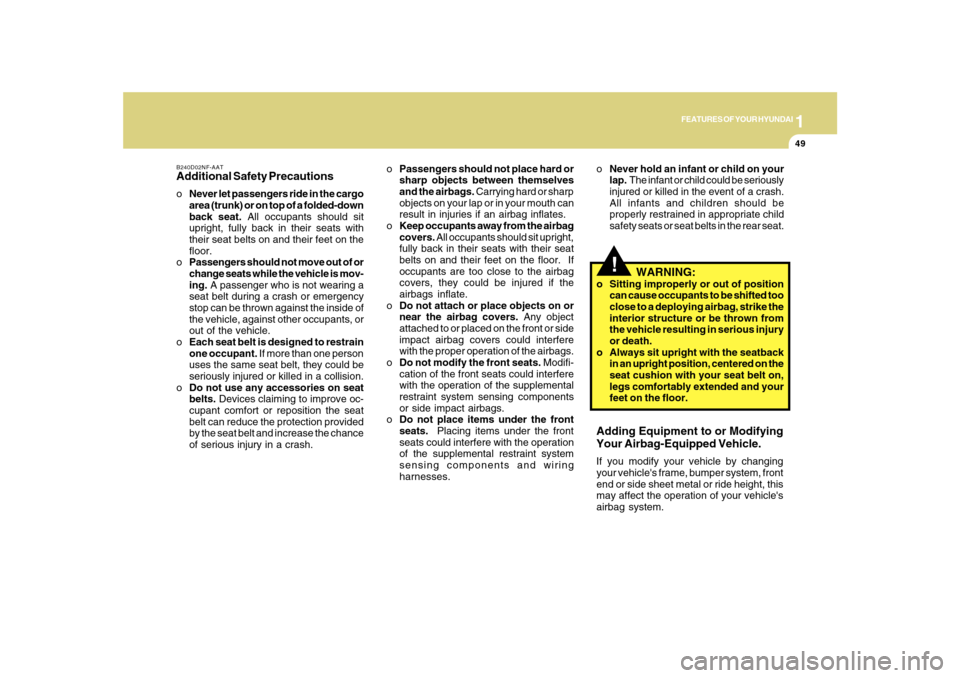
1
FEATURES OF YOUR HYUNDAI
49
B240D02NF-AATAdditional Safety PrecautionsoNever let passengers ride in the cargo
area (trunk) or on top of a folded-down
back seat. All occupants should sit
upright, fully back in their seats with
their seat belts on and their feet on the
floor.
oPassengers should not move out of or
change seats while the vehicle is mov-
ing. A passenger who is not wearing a
seat belt during a crash or emergency
stop can be thrown against the inside of
the vehicle, against other occupants, or
out of the vehicle.
oEach seat belt is designed to restrain
one occupant. If more than one person
uses the same seat belt, they could be
seriously injured or killed in a collision.
oDo not use any accessories on seat
belts. Devices claiming to improve oc-
cupant comfort or reposition the seat
belt can reduce the protection provided
by the seat belt and increase the chance
of serious injury in a crash.oPassengers should not place hard or
sharp objects between themselves
and the airbags. Carrying hard or sharp
objects on your lap or in your mouth can
result in injuries if an airbag inflates.
oKeep occupants away from the airbag
covers. All occupants should sit upright,
fully back in their seats with their seat
belts on and their feet on the floor. If
occupants are too close to the airbag
covers, they could be injured if the
airbags inflate.
oDo not attach or place objects on or
near the airbag covers. Any object
attached to or placed on the front or side
impact airbag covers could interfere
with the proper operation of the airbags.
oDo not modify the front seats. Modifi-
cation of the front seats could interfere
with the operation of the supplemental
restraint system sensing components
or side impact airbags.
oDo not place items under the front
seats. Placing items under the front
seats could interfere with the operation
of the supplemental restraint system
sensing components and wiring
harnesses.
!
WARNING:
o Sitting improperly or out of position
can cause occupants to be shifted too
close to a deploying airbag, strike the
interior structure or be thrown from
the vehicle resulting in serious injury
or death.
o Always sit upright with the seatback
in an upright position, centered on the
seat cushion with your seat belt on,
legs comfortably extended and your
feet on the floor. oNever hold an infant or child on your
lap. The infant or child could be seriously
injured or killed in the event of a crash.
All infants and children should be
properly restrained in appropriate child
safety seats or seat belts in the rear seat.Adding Equipment to or Modifying
Your Airbag-Equipped Vehicle.If you modify your vehicle by changing
your vehicle's frame, bumper system, front
end or side sheet metal or ride height, this
may affect the operation of your vehicle's
airbag system.
Page 166 of 285
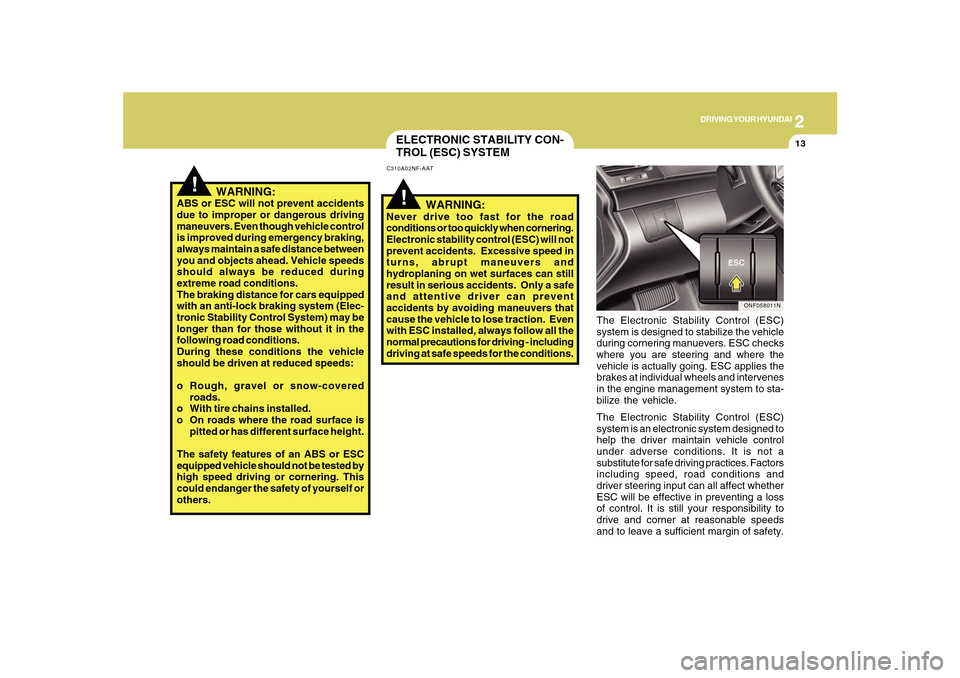
2
DRIVING YOUR HYUNDAI
13
!
!
WARNING:
ABS or ESC will not prevent accidents
due to improper or dangerous driving
maneuvers. Even though vehicle control
is improved during emergency braking,
always maintain a safe distance between
you and objects ahead. Vehicle speeds
should always be reduced during
extreme road conditions.
The braking distance for cars equipped
with an anti-lock braking system (Elec-
tronic Stability Control System) may be
longer than for those without it in the
following road conditions.
During these conditions the vehicle
should be driven at reduced speeds:
o Rough, gravel or snow-covered
roads.
o With tire chains installed.
o On roads where the road surface is
pitted or has different surface height.
The safety features of an ABS or ESC
equipped vehicle should not be tested by
high speed driving or cornering. This
could endanger the safety of yourself or
others.
ELECTRONIC STABILITY CON-
TROL (ESC) SYSTEMC310A02NF-AAT
The Electronic Stability Control (ESC)
system is designed to stabilize the vehicle
during cornering manuevers. ESC checks
where you are steering and where the
vehicle is actually going. ESC applies the
brakes at individual wheels and intervenes
in the engine management system to sta-
bilize the vehicle.
The Electronic Stability Control (ESC)
system is an electronic system designed to
help the driver maintain vehicle control
under adverse conditions. It is not a
substitute for safe driving practices. Factors
including speed, road conditions and
driver steering input can all affect whether
ESC will be effective in preventing a loss
of control. It is still your responsibility to
drive and corner at reasonable speeds
and to leave a sufficient margin of safety.
ONF058011N
WARNING:
Never drive too fast for the road
conditions or too quickly when cornering.
Electronic stability control (ESC) will not
prevent accidents. Excessive speed in
turns, abrupt maneuvers and
hydroplaning on wet surfaces can still
result in serious accidents. Only a safe
and attentive driver can prevent
accidents by avoiding maneuvers that
cause the vehicle to lose traction. Even
with ESC installed, always follow all the
normal precautions for driving - including
driving at safe speeds for the conditions.